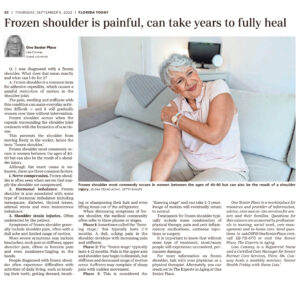

Lisa Conway – FLORIDA TODAY
Q: I was diagnosed with a frozen shoulder. What does that mean exactly and what can I do for it?
 A: Frozen shoulder is a common term for adhesive capsulitis, which causes a painful restriction of motion in the shoulder joint. The pain, swelling and stiffness with this condition can make everyday activities difficult– and it will gradually worsen over time without intervention. Frozen shoulder occurs when the capsule surrounding the shoulder joint contracts with the formation of scar tissue. This prevents the shoulder from moving freely in the socket, hence the term “frozen shoulder.”
A: Frozen shoulder is a common term for adhesive capsulitis, which causes a painful restriction of motion in the shoulder joint. The pain, swelling and stiffness with this condition can make everyday activities difficult– and it will gradually worsen over time without intervention. Frozen shoulder occurs when the capsule surrounding the shoulder joint contracts with the formation of scar tissue. This prevents the shoulder from moving freely in the socket, hence the term “frozen shoulder.”
Frozen shoulder most commonly occurs in women between the ages of 40-60 but can also be the result of a shoulder injury. Although the exact cause is unknown, there are three common factors.
- Nerve compression – Frozen shoulder is often seen when nerves that supply the shoulder are compressed.
- Hormonal imbalance – Frozen shoulder is also associated with some type of hormonal imbalance including menopause, diabetes, thyroid issues, adrenal stress and even testosterone imbalance.
- Shoulder strain injuries – often undetected by the patient
Symptoms of frozen shoulder generally include shoulder pain, often with a dull ache and limited range of motion. More severe symptoms may include headaches, neck pain or stiffness, upper shoulder pain, elbow or forearm pain and even numbness/tingling in the hands. People diagnosed with frozen shoulder often experience difficulties with activities of daily living, such as brushing their teeth, getting dressed, brushing or shampooing their hair and even lifting items out of the refrigerator.
When discussing symptoms of frozen shoulder, the medical community often refer to three phases or stages.
Phase 1- Sometimes called the “freezing stage,” this typically lasts 2-9 months. A dull, aching pain in the shoulder develops with increasing pain and stiffness.
Phase 2- The “frozen stage” typically lasts 4-12 months. Pain in the upper arm and shoulder may begin to diminish, but stiffness and decreased range of motion occur. Sufferers may complain of sharp pain with sudden movement.
Phase 3- This is considered the “thawing stage” and can take 2-3 years. Range of motion will eventually return to normal.
Treatments for frozen shoulder typically include some combination of physical therapy, pain and anti-inflammatory medications, cortisone injections or surgery. It is important to know that without some type of treatment, most/many people will experience unresolved, permanent damage.
For more information on frozen shoulder, talk with your physician or a physical therapist. Alternately, you can reach out to The Experts in Aging at One Senior Place.
###
One Senior Place is a marketplace for resources and provider of information, advice, care and on-site services for seniors and their families. Questions for this column are answered by professionals in nursing, social work, care management and in-home care. Send questions to askOSP@OneSeniorPlace.com, call 321-751-6771 or visit One Senior Place, The Experts in Aging.
Lisa Conway is a Registered Nurse and a Certified Care Manager for Senior Partner Care Services, Viera.


